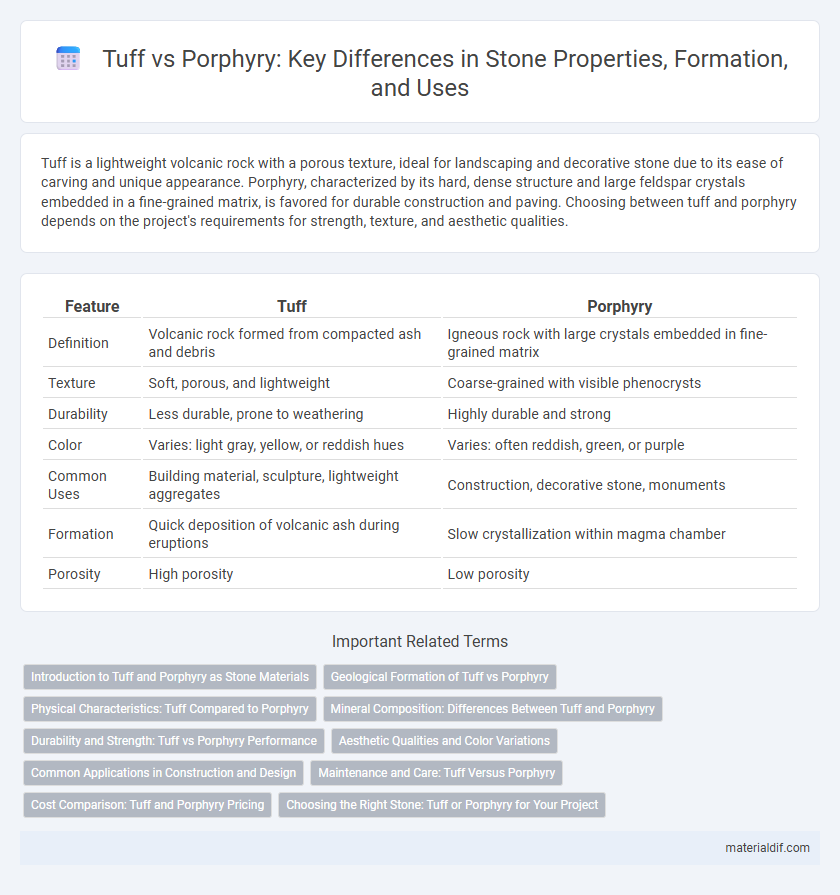Tuff is a lightweight volcanic rock with a porous texture, ideal for landscaping and decorative stone due to its ease of carving and unique appearance. Porphyry, characterized by its hard, dense structure and large feldspar crystals embedded in a fine-grained matrix, is favored for durable construction and paving. Choosing between tuff and porphyry depends on the project's requirements for strength, texture, and aesthetic qualities.
Table of Comparison
| Feature | Tuff | Porphyry |
|---|---|---|
| Definition | Volcanic rock formed from compacted ash and debris | Igneous rock with large crystals embedded in fine-grained matrix |
| Texture | Soft, porous, and lightweight | Coarse-grained with visible phenocrysts |
| Durability | Less durable, prone to weathering | Highly durable and strong |
| Color | Varies: light gray, yellow, or reddish hues | Varies: often reddish, green, or purple |
| Common Uses | Building material, sculpture, lightweight aggregates | Construction, decorative stone, monuments |
| Formation | Quick deposition of volcanic ash during eruptions | Slow crystallization within magma chamber |
| Porosity | High porosity | Low porosity |
Introduction to Tuff and Porphyry as Stone Materials
Tuff is a volcanic rock formed from consolidated volcanic ash, characterized by its lightweight and porous texture, making it ideal for construction and insulation purposes. Porphyry is an igneous rock featuring large-grained crystals embedded in a fine-grained matrix, prized for its durability and aesthetic appeal in architectural applications. Both stone materials offer unique structural properties, with tuff providing thermal insulation and porphyry delivering strength and resistance to weathering.
Geological Formation of Tuff vs Porphyry
Tuff forms from the consolidation of volcanic ash ejected during explosive eruptions, resulting in a pyroclastic rock composed mainly of volcanic fragments and minerals. Porphyry, on the other hand, develops through the slow cooling and crystallization of magma beneath the Earth's surface, characterized by large, well-formed crystals embedded in a finer-grained matrix. The key geological distinction lies in tuff's extrusive volcanic origin versus porphyry's intrusive magmatic formation.
Physical Characteristics: Tuff Compared to Porphyry
Tuff exhibits a lightweight, porous structure due to its volcanic ash composition, resulting in lower density and enhanced insulation properties compared to porphyry. Porphyry is dense and hard with large, visible mineral crystals embedded in a fine-grained matrix, providing exceptional durability and resistance. The contrasting textures influence their suitability for construction, where tuff is favored for ease of carving while porphyry supports heavy structural and decorative use.
Mineral Composition: Differences Between Tuff and Porphyry
Tuff is a volcanic rock primarily composed of consolidated volcanic ash and fragmented minerals such as quartz, feldspar, and volcanic glass, exhibiting a fine-grained texture. Porphyry, on the other hand, is an igneous rock characterized by large, well-formed crystals of feldspar or quartz embedded in a finer-grained matrix, indicating slower cooling beneath the Earth's surface. The mineral composition differences reflect their distinct formation processes, with tuff originating from explosive volcanic eruptions and porphyry forming from magma crystallizing at varying depths.
Durability and Strength: Tuff vs Porphyry Performance
Porphyry exhibits exceptional durability and strength due to its coarse-grained texture and high quartz content, making it ideal for construction requiring long-lasting materials. Tuff, while lighter and more porous, offers moderate strength but is less resistant to weathering and mechanical stress compared to porphyry. Porphyry's superior hardness and low porosity ensure enhanced performance in structural applications and outdoor environments.
Aesthetic Qualities and Color Variations
Tuff features a porous, lightweight texture with earthy tones ranging from light beige to reddish-brown, creating a natural, rustic aesthetic ideal for architectural facades and landscaping. Porphyry exhibits a dense, fine-grained matrix embedded with distinctive large, colorful crystals, offering a striking visual contrast with hues spanning deep reds, purples, greens, and grays. The color variations in porphyry enhance its decorative appeal, making it a preferred choice for high-end flooring and ornamental stonework compared to the subtler, uniform tones of tuff.
Common Applications in Construction and Design
Tuff is commonly used in lightweight construction and decorative facades due to its porous texture and ease of carving, making it ideal for architectural detailing and interior cladding. Porphyry, characterized by its hardness and durability, is favored for high-traffic areas such as pavements, curbstones, and outdoor landscaping in both modern urban and historic restoration projects. Both stones contribute unique aesthetic and functional qualities, with tuff offering thermal insulation properties and porphyry providing exceptional wear resistance.
Maintenance and Care: Tuff Versus Porphyry
Tuff requires gentle cleaning methods and regular sealing to maintain its porous surface and prevent moisture absorption, while porphyry is highly durable and demands minimal maintenance due to its dense, hard composition. Porphyry's resistance to weathering and staining makes it ideal for high-traffic outdoor areas, unlike tuff, which may require more frequent upkeep to avoid surface erosion. Choosing porphyry for stone paving reduces long-term maintenance costs compared to the delicate handling needed for tuff.
Cost Comparison: Tuff and Porphyry Pricing
Tuff typically costs less than porphyry due to its softer composition and easier quarrying process, making it a budget-friendly option for construction and landscaping. Porphyry, known for its hardness and durability, commands a higher price reflecting its superior resistance to weathering and abrasion. When comparing prices, porphyry's long-term value can offset its initial cost through reduced maintenance and enhanced longevity.
Choosing the Right Stone: Tuff or Porphyry for Your Project
Tuff, a lightweight volcanic rock, offers excellent thermal insulation and ease of carving, making it ideal for detailed architectural elements and eco-friendly building projects. Porphyry, known for its hardness and durability, is best suited for high-traffic areas such as pavements and outdoor cladding where resistance to wear and weathering is crucial. Selecting between tuff and porphyry depends on the project's structural demands, aesthetic preferences, and environmental conditions to ensure long-lasting performance and visual appeal.
Tuff vs Porphyry Infographic

 materialdif.com
materialdif.com